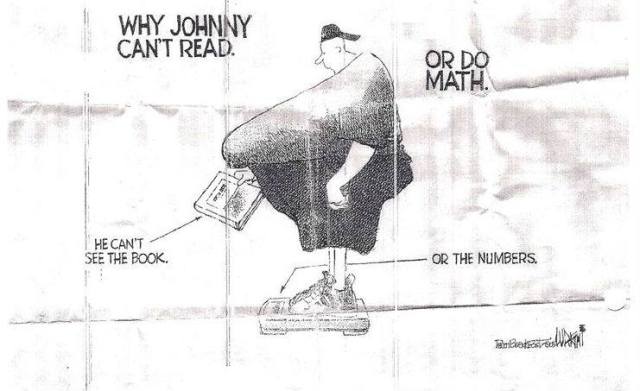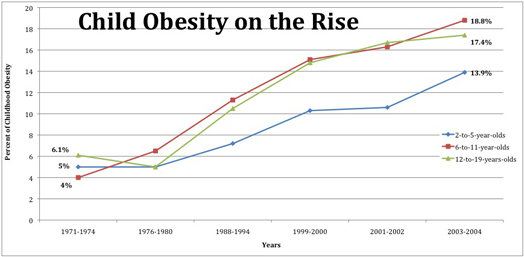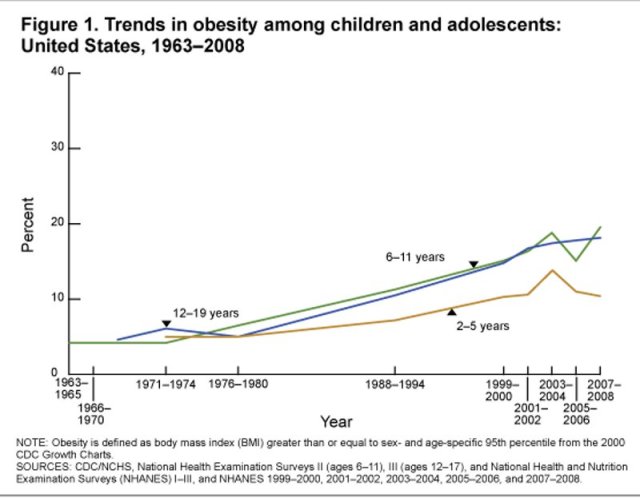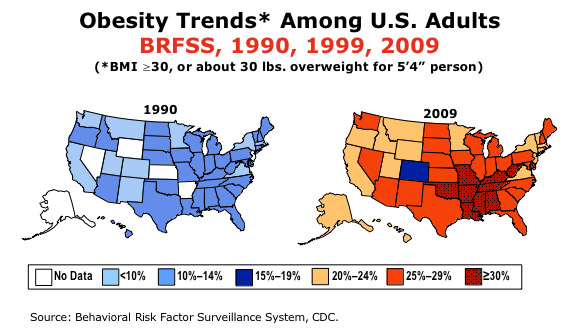A local high school health and physical education teacher circulated an editorial cartoon to her students recently as part of a discussion on diet and exercise. This was the cartoon:
A parent of one of the students contacted a local television news station, which gladly lapped up the story and stamped a “bullying” angle on it. To wit, a local anchor for the station posted the following text to accompany the cartoon:
FAT = STUPID? The father of a 9th grade girl at Mataoca [sic], who struggles with her weight, called NBC-12 to complain when this was handed out in health class. It’s a cartoon suggesting (according to the father) that heavy students aren’t as smart as thin ones. Maybe he has a point. Did the teacher bully the over-weight students, and set them up to be picked on by the other kids?
Aside from misspelling the name of the school involved, the anchor made a tremendous error at the outset that colored the rest of the conversation. Specifically, he proceeded from the false premise that the cartoon equates intelligence with obesity.
To spell it out: The cartoon uses the cultural touchstone of Rudolph Flesch’s Why Can’t Johnny Read? to highlight the modern crisis of childhood obesity. The cartoonist is in no way suggesting that obesity is literally responsible for stupidity. In other words, had there never been a famous book with that title, this cartoon would not make sense.

With the point badly missed from the outset, the pitchfork-and-torch crowd was out in full force, demanding that the teacher be fired. Naturally, the local media fanned those flames by suggesting that the use of the cartoon is “bullying” by a teacher. And how could they be reasonably expected to resist that temptation? After all, nothing short of Miley Cyrus’ tongue is more effective click-bait than “bullying.”

Let’s look at what’s really happening:
1. A health teacher presented copies of an editorial cartoon that dealt with childhood obesity. Again—this is a health class.
2. The teacher did not draw the cartoon herself.
3. The teacher did not single out any students in her class or address this cartoon to particular students.
4. The cartoon does not suggest that obese children are actually less intelligent than non-obese children.
In short, the teacher did absolutely nothing wrong. However, we have a much larger problem than whether this one teacher is disciplined over showing her class this cartoon.
If we live in a world in which a teacher handing out a contextually-appropriate editorial cartoon to every student is committing an act of “bullying,” then anti-bullying suddenly becomes a dangerous instrument.
One common refrain in the comments to the story was the invocation of a suicide-prevention justification. Critics used this rationale as reason for taking any action, no matter how overbroad, in the name of putting an end to bullying. The premise is that bullying is worse than ever, and yout suicide is likewise worse than ever as a result. Let’s look at the numbers[1]:
Youth Suicide Rate (1990): 13.2
Youth Suicide Rate (2010): 10.5
Over the last quarter-century or so, the suicide rate has risen and fallen incrementally, fluctuating a bit over time. If anything, the overall rate has declined slightly . Let’s look at another set of numbers:
That’s what an epidemic looks like.
If we’re so oversensitive to anti-bullying that we won’t even allow health teachers use an obesity-related editorial cartoon, reversing American obesity trends will be next-to-impossible. Teachers (understandably) will want to protect their jobs. If the teacher in this case were fired, the upshot of this entire episode would be that other educators in the same jurisdiction (perhaps beyond) might decide that it’s just not worth it even to broach the subject.
For the folks who want this person fired on the grounds that such a cartoon might hurt the feelings of an obese student, I would ask this question: When a gym class is required to run a couple of laps, for example, will the obese student’s feelings be hurt as he struggles to make it around the track?
If so, is a teacher who asks overweight students to run a “bully” for subjecting them to this humiliation? Should overweight students be required to run or play any sports that require cardiovascular fitness? Should anyone ever have to do anything that may cause hurt feelings?
Or, do we do ourselves a societal disservice when we value feelings above everything, even when we know that the road to self-improvement often doesn’t feel good.
Until we reach the destination, that is.
Not all criticism is “bullying,” especially when it’s constructive. On top of that, I’m not even sure that a cartoon making a contextually-relevant point is specific enough to be considered “criticism” as to any individual student. Either way, educators must be free to provide instruction that helps to combat real issues that our nation’s youth faces. Needless to say, obesity, nutrition, and physical fitness are all such issues.
To be clear: We need to be vigilant in stopping bullying. Bullying is a real problem. But not everything that might make us feel bad is bullying. A broad belief that material that is educationally relevant is nonetheless “bullying” does more damage to our society than bullying itself.
________
[1] For Americans aged 15-24, per 100,000 population. Source. 2010 source.








Pingback: Best of 2013 | The Axis of Ego
Vhy don’t you have anover donut, fatty?
First, let me say that I totally agree that this falls outside the realm of “bullying”. That being said, I’m curious as to what the point of the teacher circulating the cartoon was. If the teacher had circulated charts like the ones you show in your column (which the teacher may already additionally do), I think that would be more of an eye-opener than a cartoon. But I can’t think of another reason to show the cartoon other than to shame obese students without any real educational value.
Sadly, the majority of people do not look at these things this way. They are looking for things to “jump” on as “bullying”. I, myself, have not heard of this book, “Why Can’t Johnny Read?” so I did not make the connection as most of you that know this book did. I took it as a not so funny Editorial Cartoon. I do, however, agree that the “bullying” issue has been taken too far and many people classify any criticism they do not want to hear is “bullying”. I am glad that I was bullied when I was a kid because it taught me how to deal with these kinds of people and how to stand up for myself and what I believed in.
This whole deal, however, comes from a different problem. People are too stupid to get a joke. I don’t think the cartoon was particularly funny, but it is obvious to anyone with half a brain what was trying to be conveyed. Something similar, but different, that I ran across a couple weeks ago was the whole “thigh gap” controversy. Look at those graphs and charts in the middle of this article again. Is the fact that some girls want to be thin enough to have a thigh gap really the primary problem in our schools. If you see a girl walking around school who’s actually in the healthy BMI range, the other girls will say smart aleck stuff to them about eating disorders. The bottom line is that the number of girls who legitimately have eating disorders is tiny, while the percent that need to put down the Twinkie box is pretty high (I do too). So what we’ve created is a situation where a person legitimately pointing out to a class that there is a real problem with being obese is considered bullying, but the kids who have the legitimate problem feel free to criticize the kids who exercise and eat the way they’re supposed to and that isn’t considered bullying.
Yeah, what’s troubling to me is that you had a random parent who didn’t even understand the cartoon take it to a local news outlet, and, rather than calmly and politely decline to carry his incorrect reading of it, ALSO COULDN’T DIAGNOSE IT PROPERLY!
If professional journalists in a second-tier market don’t have the cultural literacy to get a “Why Can’t Johnny Read?” reference, then how can we expect them to have the intellect to present complex issues to the public?
Personally I think the second-tier news outlet had full knowledge of what “Why Can’t Johnny Read?” meant, and ran with a story regardless. “Health Teacher Bullying Obese Students by Handing Out Offensive Comic,” can be used as a headline without ever acknowledging the title phrase.